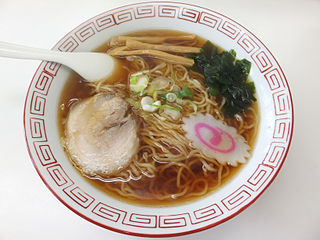
Japanese cuisine encompasses the regional and traditional foods of Japan, which have developed through centuries of political, economic, and social changes. The traditional cuisine of Japan is based on rice with miso soup and other dishes; there is an emphasis on seasonal ingredients. Side dishes often consist of fish, pickled vegetables, and vegetables cooked in broth. Seafood is common, often grilled, but also served raw as sashimi or in sushi. Seafood and vegetables are also deep-fried in a light batter, as tempura. Apart from rice, a staple includes noodles, such as soba and udon. Japan also has many simmered dishes, such as fish products in broth called oden, or beef in sukiyaki and nikujaga.

Ramen is a Japanese noodle dish. It consists of Chinese-style wheat noodles served in a broth; common flavors are soy sauce and miso, with typical toppings including sliced pork, nori, menma, and scallions. Ramen has its roots in Chinese noodle dishes. Nearly every region in Japan has its own variation of ramen, such as the tonkotsu ramen of Kyushu and the miso ramen of Hokkaido.

Tempura is a typical Japanese dish that usually consists of seafood and vegetables that have been coated in a thin batter and deep fried.

Soba is a thin Japanese noodle made from buckwheat. The noodles are served either chilled with a dipping sauce, or hot in a noodle soup. The variety Nagano soba includes wheat flour.

Udon is a thick noodle made from wheat flour, used in Japanese cuisine. There is a variety of ways it is prepared and served. Its simplest form is in a soup as kake udon with a mild broth called kakejiru made from dashi, soy sauce, and mirin. It is usually topped with thinly chopped scallions. Other common toppings include prawn tempura, kakiage, abura-age, kamaboko, and shichimi spice added to taste.

Noodles are a staple of Japanese cuisine. They are often served chilled with dipping sauces, or in soups or hot dishes. Noodles were introduced to Japan from China during the Song Dynasty between the Heian until the early Kamakura period.

Noodle soup refers to a variety of soups with noodles and other ingredients served in a light broth. Noodle soup is a common dish across East Asia, Southeast Asia and the Himalayan states of South Asia. Various types of noodles are used, such as rice noodles, wheat noodles and egg noodles.

Shrimp or prawn dishes are often prepared by frying, especially deep frying. There are several styles.

Japanese Chinese cuisine, also known as Chūka, represents a unique fusion of Japanese and Chinese culinary traditions that have evolved over the late 19th century and more recent times. This style, served predominantly by Chinese restaurants in Japan, stands distinct from the "authentic Chinese food" found in areas such as Yokohama Chinatown. Despite this difference, the cuisine retains strong influences from various Chinese culinary styles, as seen in the Shippoku cooking style.

JINYA Ramen Bar is a chain of restaurants based in Los Angeles, California, specializing in ramen noodle dishes. The restaurants are located across the Lower 48, Washington DC, and Hawaii in the US; and Vancouver and Calgary in Canada. Los Angeles food critic Jonathan Gold has praised the restaurant.

Tsukemen is a ramen dish in Japanese cuisine consisting of noodles that are eaten after being dipped in a separate bowl of soup or broth. The dish was invented in 1961 by Kazuo Yamagishi, a restaurateur in Tokyo, Japan. Since then, the dish has become popular throughout Japan, as well as overseas in the United States.

A ramen shop is a restaurant that specializes in ramen dishes, the wheat-flour Japanese noodles in broth. In Japan, ramen shops are very common and popular, and are sometimes referred to as ramen-ya(ラーメン屋) or ramen-ten(ラーメン店). Some ramen shops operate in short order style, while others provide patrons with sit-down service. Over 10,000 ramen shops exist in Japan. In recent times, ramen shops have burgeoned in some cities in the United States, such as Chicago, Los Angeles, and New York City.
Aburasoba (油そば), also known as maze soba, monjasoba (もんじゃそば), tenukisoba (手抜きそば), abu ramen (あぶラーメン) or shirunashi ramen (汁なしラーメン), is a dry noodle dish made with a sauce of soy sauce and pork lard. Traditional ingredients include shoyu tare base, aroma oil, menma, shredded nori, and green onions. Other variations also include toppings like raw garlic, raw egg, cheese, and minced meat, which are mixed with the noodles before eating.
Kazuo Yamagishi (1934-2015) was a Japanese chef, who is known for inventing the tsukemen dish. He was born in Nagano Prefecture, and came upon the idea of Tsukemen at the age of 17 after seeing a co-worker eating noodles dipped in a soup bowl. In 1961, he added tsukemen, then named "special morisoba", to his Taishoken restaurant.













